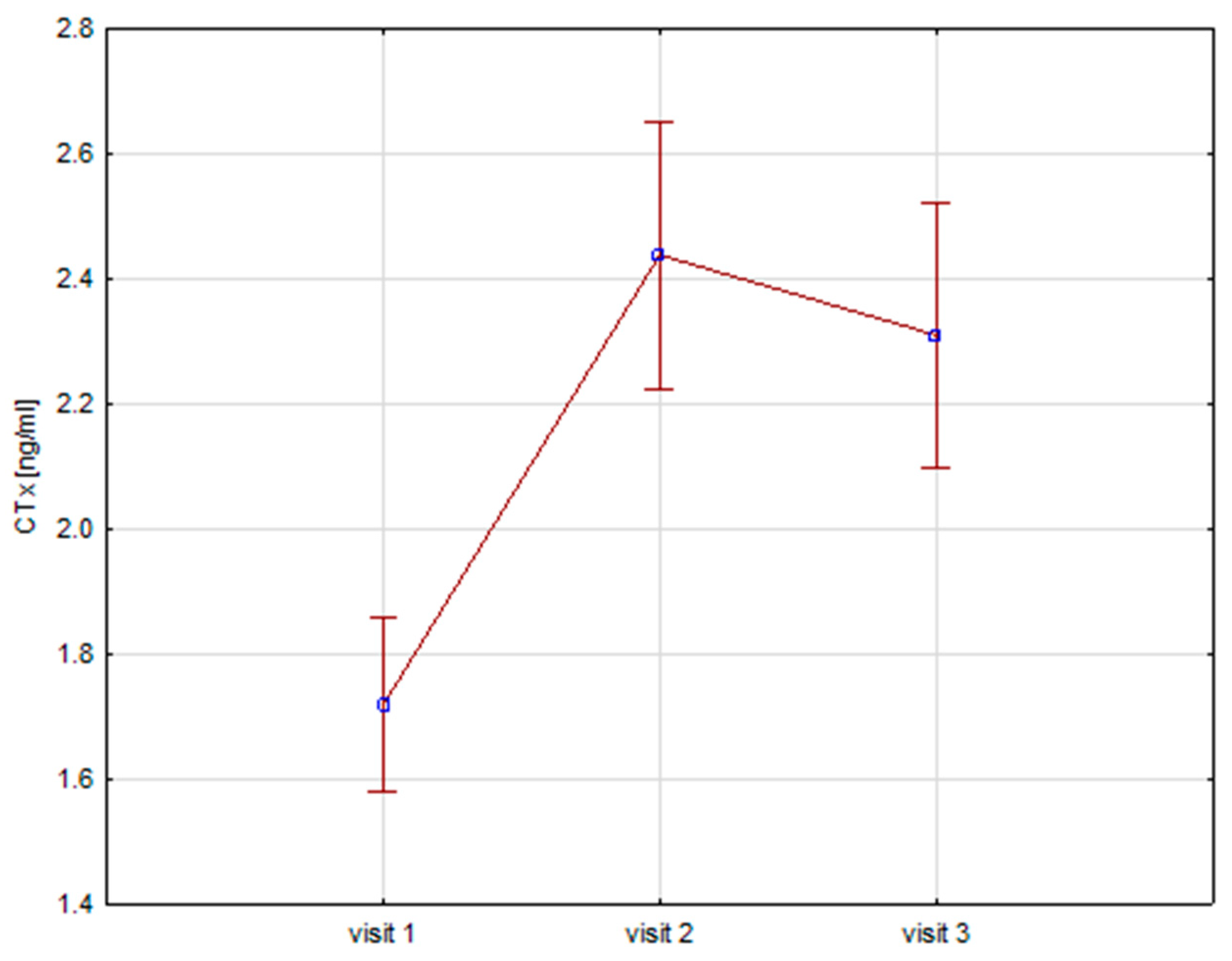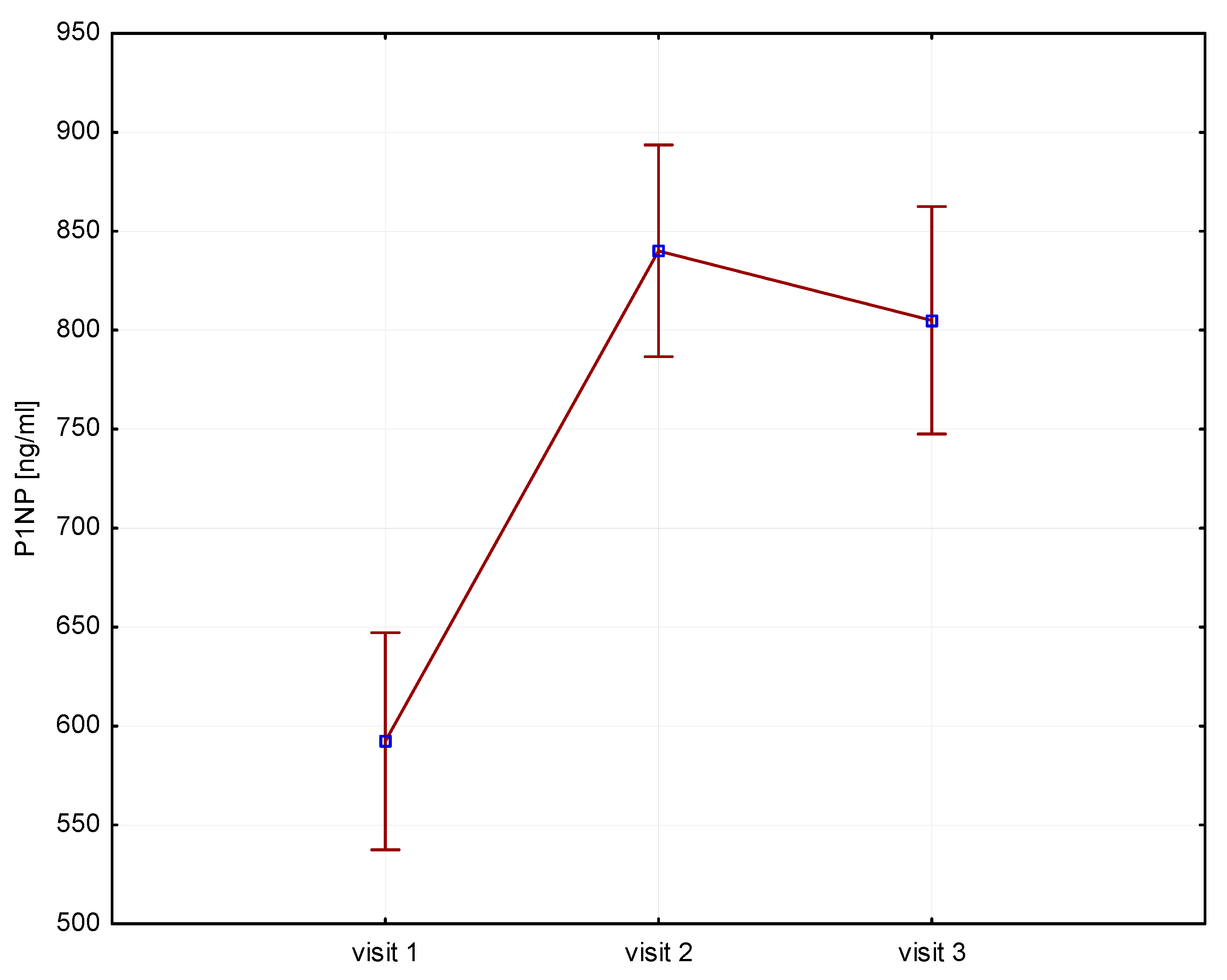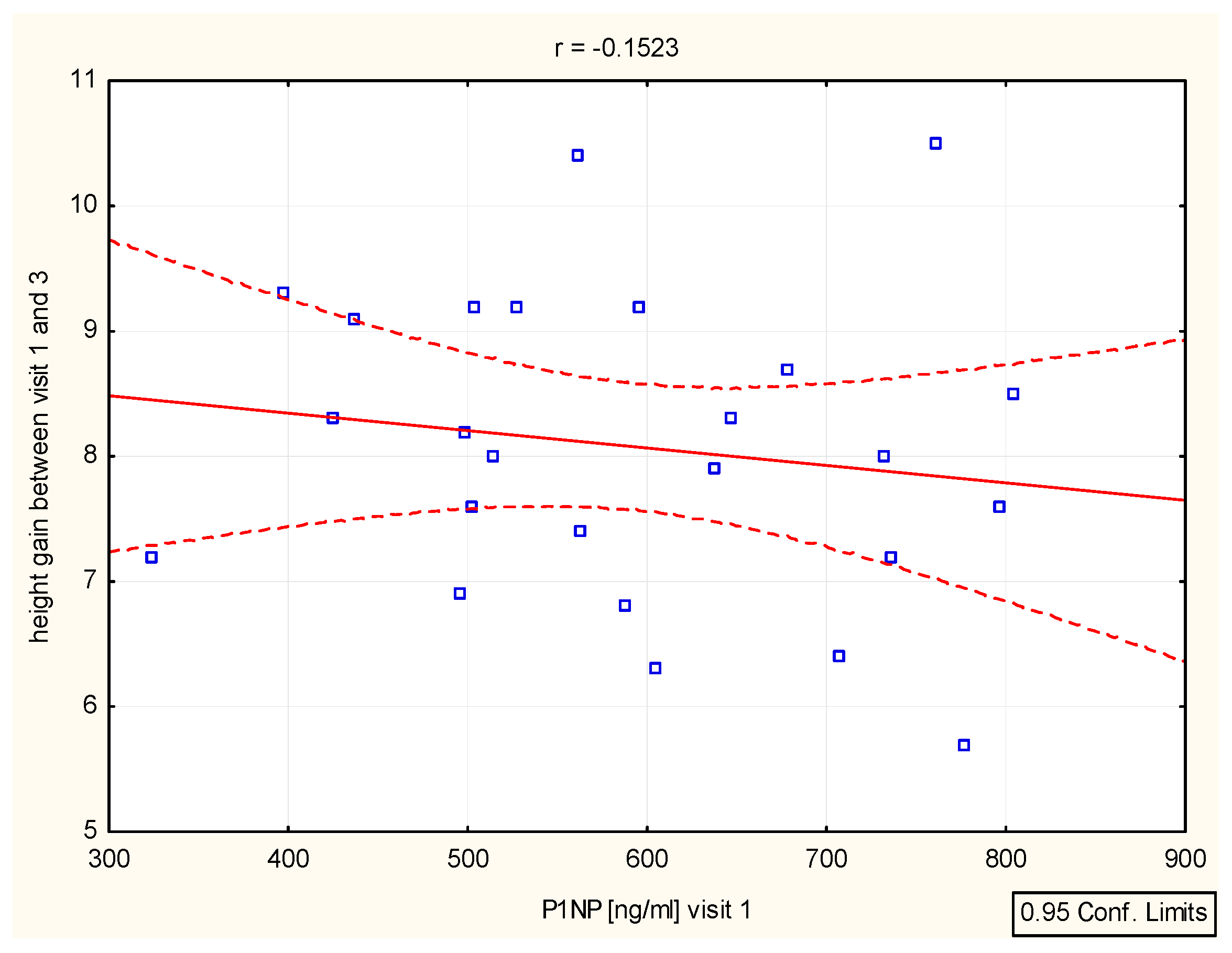Bone Turnover Markers during Growth Hormone Therapy for Short Stature Children Born Small for Gestational Age
Abstract
1. Introduction
2. Material and Methods
2.1. Study Population
2.2. Methods
2.3. Statistical Methods
3. Results
Correlations
4. Discussion
5. Conclusions
Author Contributions
Funding
Institutional Review Board Statement
Informed Consent Statement
Data Availability Statement
Conflicts of Interest
Abbreviations
| SGA | small for gestational age; |
| Hbd | duration of pregnancy; |
| BMI | body mass index; |
| BA | bone age; |
| HT | height; |
| IGF1 | somatomedin C; |
| CTx | C-terminal telopeptide of collagen type I; |
| P1NP | N-terminal procollagen type 1; |
| P3NP | N-terminal procollagen type 3; |
| NT | pro-CNP-amino-terminal C-type natriuretic peptid; |
| Ca | calcium |
| P | posphorus |
| ALP | alkaline phosphatase |
| PTH | parathormone |
| 25OHD3 | vitamin D3 |
References
- Szulc, P.; Seeman, E.; Delmas, P.D. Biochemical measurements of bone turnover in children and adolescents. Osteoporos. Int. 2000, 11, 281–294. [Google Scholar] [CrossRef] [PubMed]
- van de Lagemaat, M.; Rotteveel, J.; van Weissenbruch, M.M.; Lafeber, H.N. Small-for-gestational-age preterm-born infants already have lower bone mass during early infancy. Bone 2012, 51, 441–446. [Google Scholar] [CrossRef] [PubMed]
- van de Lagemaat, M.; van der Veer, E.; van Weissenbruch, M.M.; Lafeber, H.N.; Rotteveel, J. Procollagen type I N-terminal peptide in preterm infants is associated with growth during the first six months post-term. Clin. Endocrinol. 2014, 81, 551–558. [Google Scholar] [CrossRef]
- Longhi, S.; Mercolini, F.; Carloni, L. Prematurity and low birth weight lead to altered bone geometry, strenght, and quality in children. J. Endocrinol. Investig. 2015, 38, 563–568. [Google Scholar] [CrossRef]
- Nordman, H.; Voutiainen, R.; Laitinen, T. Birth size, body composition, and adrenal androgens as determinants of bone mineral density in mid-childhood. Pediatr. Res. 2018, 83, 993–998. [Google Scholar] [CrossRef]
- Maruyama, H.; Amari, S.; Fujinaga, H. Bone fracture in severe small-for-gestational-age, extremely low birth weight infants: A single-center analysis. Early Hum. Dev. 2017, 106–107, 75–78. [Google Scholar] [CrossRef]
- Buttazzoni, C.; Rosengren, B.; Tveit, M. Preterm children born small-for-gestational-age are et risk for low adult bone mass. Calcif. Tissue Int. 2016, 98, 105–113. [Google Scholar] [CrossRef] [PubMed]
- Balasuriya, C.; Evensen, K.; Mosti, M. Peak bone mass and bone microarchitecture in adults born with low birth weight preterm or at term: A cohort study. J. Clin. Endocrinol. Metab. 2017, 102, 2491–2500. [Google Scholar] [CrossRef]
- Namgung, R.; Tsang, R.; Sierra, R. Normal serum indices of bone collagen biosyntesis and degradation in small for gestational age infants. J. Peditar Gastroenterol. Nutr. 1996, 23, 224–228. [Google Scholar]
- Rojo-Trejo, M.; Robles-Osorio, M.; Rangel, B. Appendicular muscle mass index as the most important determinant of bone mineral content and density in small for gestational age children. Clin. Pediatr. 2024. [Google Scholar] [CrossRef]
- Silvano, L.; Miras, M.; Perez, A. Comparative analysis of clinical, biochemical and genetic aspects associated with bone mineral density in small for-gestational age children. J. Pediatr. Endocrinol. Metab. 2011, 24, 511–517. [Google Scholar] [CrossRef] [PubMed]
- Lanes, R. Growth velocity, final height and bone mineral metabolism of short children treated long term with growth hormone. Curr. Pharm. Biotechnol. 2000, 1, 33–46. [Google Scholar] [CrossRef] [PubMed]
- Schonau, E.; Westermann, F.; Rauch, F.; Stabrey, A.; Wassmer, G.; Keller, E.; Bramswig, J.; Blum, W.F. A new and acurate prediction model for growth response to growth hormone treatment in children with growth hormone deficiency. Eur. J. Endocrinol. 2001, 144, 13–20. [Google Scholar] [CrossRef]
- Cowell, C.T.; Woodhead, H.J.; Brody, J. Bone markers and bone mineral density during growth hormone treatment in children with growth hormone deficiency. Horm. Res. 2000, 54, 44–51. [Google Scholar] [CrossRef] [PubMed]
- Hogler, W.; Shaw, N. Childhood growth hormone deficiency, bone density, structures and fractures: Scrutinizing the evidence. Clin. Endocrinol. 2010, 72, 281–289. [Google Scholar] [CrossRef]
- Saggese, G.; Baroncelli, G.I.; Bertelloni, S.; Cinquanta, L.; Di Nero, G. Effect of long term treatment with growth hormone on bone and mineral metabolismin children with growth hormone deficiency. J. Pediatr. 1993, 122, 37–45. [Google Scholar] [CrossRef]
- Ogle, G.D.; Rosenberg, A.R.; Calligeros, D.; Kainer, G. Effects of growth hormone treatment for short stature on calcium homeostasis, bone mineralization and body composition. Horm. Res. 1994, 41, 16–20. [Google Scholar] [CrossRef] [PubMed]
- Kandemir, N.; Nazli Gonc, E.; Yordam, N. Responses of bone turnover markers and bone mineral density to growth hormone therapy in children with Isolated Growth Hormone Deficiency and Multiple Pituitary Hormone Deficiency. J. Clin. Endocrinol. Metab. 2002, 15, 809–816. [Google Scholar]
- Li, Y.; Chen, L.Q.; Liang, L. Effects of recombinant human growth hormone (GH) replacement therapy on bone metabolism in children with GH deficiency. J. Zhejiang Univ. Med. Sci. 2005, 34, 312–315. [Google Scholar]
- Baroncelli, G.; Bertelloni, S.; Ceccarelli, C. Dynamics of bone turnover in children with GH deficiency treated with GH until final height. Eur. J. Endocrinol. 2000, 142, 549–556. [Google Scholar] [CrossRef]
- Schweizer, R.; Martin, D.D.; Schwarze, C.P.; Binder, G.; Georgiadou, A.; Ihle, J.; Ranke, M.B. Cortical bone density is normal in prepubertal children with growth hormone (GH) deficiency, but initialy decreases during GH replacement due to early bone remodeling. J. Clin. Endocrinol. Metab. 2003, 88, 5266–5272. [Google Scholar] [CrossRef] [PubMed][Green Version]
- Willemsen, R.; Arends, N.; Bakker-van Waarde, W. Long-term effects of growth hormon (GH) treatmenton body composition and bone mineral density in short children born small-for-gestational-age: Six year follow up of randomized controlled GH trial. Clin. Endocrinol. 2007, 67, 485–492. [Google Scholar] [CrossRef] [PubMed]
- De Zegher, F.; Butenandt, O.; Chatelain, P. Growth hormone treatment of short children born small for gestational age:reappraisal of the rate of bone maturation over 2 years and metanalysis of height gain over 4 years. Acta Paediatr. Supp. 1997, 423, 207–212. [Google Scholar] [CrossRef] [PubMed]
- Gascoin-Lachambre, G.; Trivin, C.; Brauner, R.; Souberbielle, J.C. Serum procollagen type 1 amino-terminal propeptide (P1NP) as an early predictor of the growth responsin she to growth hormone treatment: Comparison of intrauterine growth retardation and idiopathic short stature. Growth Horm. 2007, 17, 194–200. [Google Scholar] [CrossRef]
- Lanes, R.; Gunczler, P.; Esaa, S.; Weisinger, J.R. The effect of short- and long-term growth hormone treatment on bone mineral density and bone metabolism of prepubertal children with idiopathic short stature: A 3-year study. Clin. Endocrinol. 2002, 57, 725–730. [Google Scholar] [CrossRef]
- Kamp, G.A.; Zwinderman, A.H.; Doorn, J.V. Biochemical markers of growth hormone (GH) sensitivity in children with idiopathic short stature: Individual capacity of IGF-I generation after high-dose GH treatment determines the growth response to GH. Clin. Endocrinol. 2002, 57, 315–325. [Google Scholar] [CrossRef]
- Bajoria, R.; Sooranna, S.R.; Chatterjee, R. Type 1 collagen marker of bone turnover, insulin-like growth factor, and leptin in dichorionic twins with discordant birth weight. J. Clin. Endocrinol. Metab. 2006, 91, 4696–4701. [Google Scholar] [CrossRef] [PubMed][Green Version]
- Prickett, T.C.; Lynn, A.M.; Barrell, G.K.; Darlow, B.A.; Cameron, V.A.; Espiner, E.A.; Richards, A.M.; Yandle, T.G. Amino-Terminal proCNP: A Putative Marker of Cartilage Activity in Postnatal Growth. Pediatr. Res. 2005, 58, 334–340. [Google Scholar] [CrossRef]
- Lem, A.J.; Van der Kaay, D.C.; Hokken-Koelega, A.C. Bone mineral density and body composition in short children born SGA during growth hormone and gonadotropin releasing hormone analog treatment. J. Clin. Endocrinol. Metab. 2013, 98, 77–86. [Google Scholar] [CrossRef]
- Arends, N.J.; Boonstra, V.H.; Mulder, P.G.; Odink, R.J.; Stokvis-Brantsma, W.H.; Rongen-Westerlaken, C.; Mulder, J.C.; Delemarre-Van de Waal, H.; Reeser, H.M.; Jansen, M.; et al. GH treatment and its effect on bone mineral density, bone maturation and growth in short children born small for gestational age: 3-year results of a randomized, controlled GH trial. Clin. Endocrinol. 2003, 59, 779–787. [Google Scholar] [CrossRef]
- Gerwert, U.; Hoyle, N. Application Report P1NP; Elecsys, Roche Diagnostics GmbH: Mannheim, Germany, 2010. [Google Scholar]
- Seibel, M.J. Molecular markers of bone turnover: Biochemical technical and analytical aspects. Osteoporosis 2000, 11, S18–S29. [Google Scholar] [CrossRef] [PubMed]
- Rauch, F.; Georg, M.; Stabrey, A.; Neu, C.; Blum, W.F.; Remer, T.; Manz, F.; Schoenau, E. Collagen markers deoxypyridinoline and hydroxylysine glycosides: Pediatric reference data and use growth prediction in growth hormone-deficient children. Clin. Chem. 2002, 48, 315–322. [Google Scholar] [CrossRef] [PubMed]
- Bhasin, S.; He, E.J.; Kawakubo, M.; Schroeder, E.T.; Yarasheski, K.; Opiteck, G.J.; Reicin, A.; Chen, F.; Lam, R.; Tsou, J.A.; et al. N-terminal propeptide of type III procollagen as a biomarker of anabolic response to recombinant human GH and testosteron. J. Clin. Endocrinol. Metab. 2009, 94, 4224–4233. [Google Scholar] [CrossRef] [PubMed]





| SGA | |
|---|---|
| Age (years) | 7.6 ± 1.8 |
| Hbd (weeks) | 36.4 Hbd ± 4.11 |
| Born weight (g) | 1776.5 ± 699 (−3.3 SD) |
| Born height (cm) | 44.9 ± 6.9 (−1.2 SD) |
| Height at v1 (cm) | 111.8 ± 10.3 (−2.7 SD) |
| Weight at v1 (g) | 16.6 kg ± 3.4 (−3.34 SD) |
| BMI at v1 (m2/kg) | 13.1 ± 0.8 (−2 SD) |
| BA (years) | 5.4 ± 1.9 |
| Height (cm) zscore | Weight (kg) zscore | BMI (m2/kg) zscore | IGF1 (ng/mL) zscore | CTX (ng/mL) zscore | P1NP (ng/mL) zscore | P3NP (µg/L) zscore | NT-proCNP (pmol/L) zscore | |
|---|---|---|---|---|---|---|---|---|
| Visit 1 | 111.8 (−2.7 SD) | 16.68 (−3.34 SD) | 13.18 (−2.04 SD) | 141 | 1.7 | 592 | 13 | 57 |
| Visit 2 | 115.82 (−2.46 SD) | 17.99 (−3.06 SD) | 13.24 (−2.04 SD) | 310 | 2.4 | 840 | 14.1 | 60 |
| Visit 3 | 119.93 (−2.19 SD) | 19.74 (−2.69 SD) | 13.52 (−1.87SD) | 349 | 2.3 | 804 | 14.8 | 58.16 |
| p (v1–v3) | p = 0.000 | p = 0.000 | p = 0.000 | p = 0.000 | p = 0.000 | p = 0.000 | p = 0.000 | n.s. |
| Ca (ng/mL) | P (ng/mL) | ALP (ng/mL) | PTH | 25OHD3 | |
|---|---|---|---|---|---|
| Visit 1 | 2.42 ± 0.1 | 1.49 ± 0.13 | 231.62 ± 42 | 22.00 ± 9.11 | 31 ± 7.7 |
| Visit 2 | 2.46 ± 0.1 | 1.62 ± 0.16 | 277.32 ± 56 | 29.48 ± 19.22 | 32.9 ± 7.4 |
| Visit 3 | 2.46 ± 0.1 | 1.6 ± 0.14 | 282.96 ± 52 | 24.87 ± 17.20 | 35.18 ± 10 |
| p (v1–v3) | 0.098 | 0.001 | 0.0012 | 0.03 | 0.06 |
| CTX v1 | CTX v2 | CTX v3 | P1NP v1 | P1NP v2 | P1NP v3 | Ca v1 | Ca v2 | Ca v3 | |
|---|---|---|---|---|---|---|---|---|---|
| HT cm SD Visit 1 | r = 0.1 r = −0.17 | r = 0.4 (p = 0.047) r = 0.14 | r = 0.35 r = −0.08 | r = 0.25 r = −0.05 | r = 0.03 r = 0.00 | r = 0.37 r = 0.38 | r = −0.14 r = −0.16 | r = −0.10 r = 0.14 | r = 0.3 r = 0.53 |
| HT cm SD Visit 2 | r = 0.07 r = −0.25 | r = 0.39 (p = 0.046) r = 0.15 (p = 0.049) | r = 0.34 r = −0.10 | r = 0.22 r = −0.13 | r = 0.03 r = 0.03 | r = 0.37 r = 0.41 (p = 0.041) | r = −0.13 r = −0.13 | r = −0.15 r = 0.16 | r = 0.25 0.49 |
| Ht cm SD Visit 3 | r = 0.05 r = −0.27 | r = 0.4 (p = 0.046) r = 0.17 | r = 0.33 r = −0.09 | r = 0.22 r = −0.10 | r = 0.04 r = 0.09 | r = 0.38 r = 0.44 (p = 0.025) | r = −0.11 r = −0.08 | r = −0.20 r = 0.09 | r = 0.24 r = 0.48 (p = 0.014) |
Disclaimer/Publisher’s Note: The statements, opinions and data contained in all publications are solely those of the individual author(s) and contributor(s) and not of MDPI and/or the editor(s). MDPI and/or the editor(s) disclaim responsibility for any injury to people or property resulting from any ideas, methods, instructions or products referred to in the content. |
© 2024 by the authors. Licensee MDPI, Basel, Switzerland. This article is an open access article distributed under the terms and conditions of the Creative Commons Attribution (CC BY) license (https://creativecommons.org/licenses/by/4.0/).
Share and Cite
Korpysz, A.; Jaworski, M.; Skorupa, E.; Szalecki, M.; Walczak, M.; Petriczko, E. Bone Turnover Markers during Growth Hormone Therapy for Short Stature Children Born Small for Gestational Age. Biomedicines 2024, 12, 1919. https://doi.org/10.3390/biomedicines12081919
Korpysz A, Jaworski M, Skorupa E, Szalecki M, Walczak M, Petriczko E. Bone Turnover Markers during Growth Hormone Therapy for Short Stature Children Born Small for Gestational Age. Biomedicines. 2024; 12(8):1919. https://doi.org/10.3390/biomedicines12081919
Chicago/Turabian StyleKorpysz, Alicja, Maciej Jaworski, Ewa Skorupa, Mieczysław Szalecki, Mieczysław Walczak, and Elżbieta Petriczko. 2024. "Bone Turnover Markers during Growth Hormone Therapy for Short Stature Children Born Small for Gestational Age" Biomedicines 12, no. 8: 1919. https://doi.org/10.3390/biomedicines12081919
APA StyleKorpysz, A., Jaworski, M., Skorupa, E., Szalecki, M., Walczak, M., & Petriczko, E. (2024). Bone Turnover Markers during Growth Hormone Therapy for Short Stature Children Born Small for Gestational Age. Biomedicines, 12(8), 1919. https://doi.org/10.3390/biomedicines12081919






